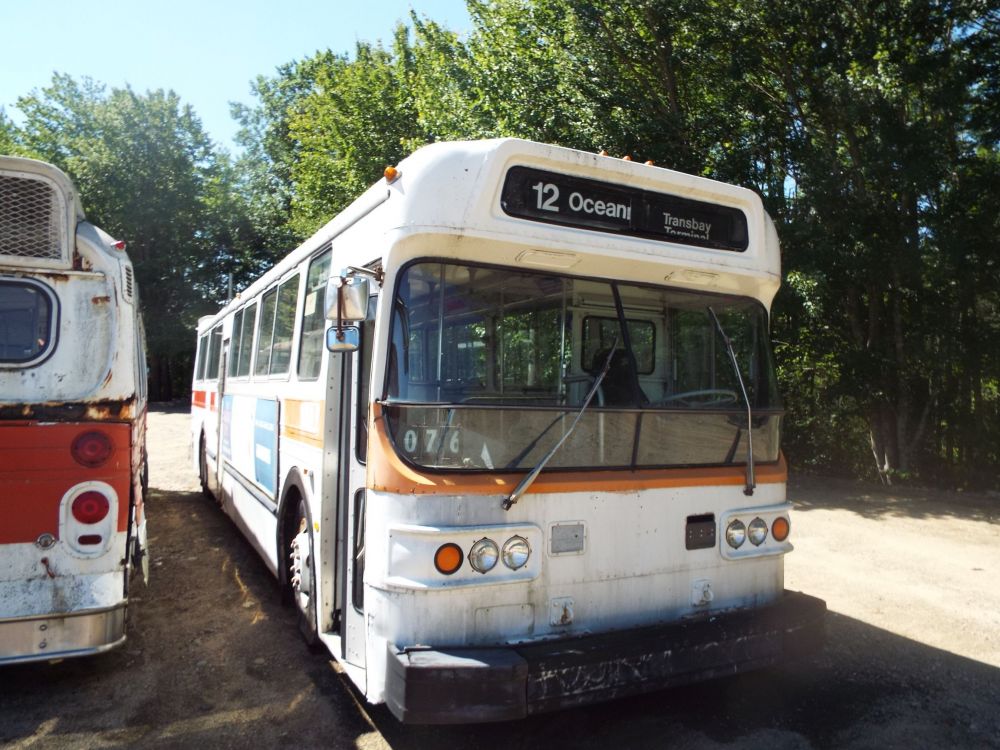
Kenyon F. Karl on 7/31/20
- Builder
- Flyer Industries
- Description
- E-800 Trolley Coach
- Type
- Trackless Trolleys
- Year
- 1976
- Retired from Service
- 2007
- Acquired by the Museum
- 2015
- Fund
- 841
San Francisco Municipal Ry. 5148
From San Francisco, California
History
Flyer Industries’ predecessor, Western Auto & Truck Body, based in Winnipeg, Manitoba, began producing buses in 1937. The company was renamed Western Flyer Coach in 1945. The Manitoba government acquired the company when it was failing financially in 1971 and renamed it Flyer Industries. Flyer Industries began building electric trolley buses in 1968 with its model E-700 after traditional builders of trackless trolleys had left the market. Flyer introduced its series 800, available in either diesel or electric coaches, in 1973. Flyer designed these vehicles with a lightweight aluminum body, air-assisted steering and a large windshield. The province privatized Flyer Industries in 1986 when it became New Flyer Industries.
Trolley buses, also termed “trackless trolleys,” have some advantages as transit vehicles. They can accelerate and brake better than motor buses, and they have no exhaust and are almost silent. They are the best transit vehicles (aside from cable cars) for climbing and descending steep hills. A downside for trolley buses is their two overhead wires (thought by some to be unsightly) which are required to complete the electric circuit unlike streetcars which use rails for the return current. More importantly, until the 1990s, trolley buses were restricted to streets with the overhead wires. Since then, all newly manufactured trolley buses are equipped with auxiliary battery power which allows them to bypass streets undergoing construction and to extend service beyond the end point of the overhead wires. In the 1950s and 1960s, most North American transit operators replaced trolley bus routes with more versatile motor buses.
With its famous hills, trolley buses were particularly suited for San Francisco. The city’s first trolley bus operation was in 1935 when the Market Street Railway converted a streetcar line to trolley bus. The city’s other transit operator, San Francisco Municipal Railway (Muni), began using trolley buses in 1941. Market Street Railway merged into Muni in 1944. During the 1940s and 1950s, Muni converted most of its streetcar lines to trolley buses. Because of the city’s steep grades and low cost electricity, San Francisco continued using trolley buses when most other cities were converting trolley bus routes to diesel buses. In fact, between 1981 and 1993, Muni converted several routes from diesel bus to trolley bus operation. In 1971 and 1973, the system purchased two Flyer Industries model E-700 trolley coaches. Apparently these were successful. So Muni ordered 343 model E-800 coaches (Nos. 5003 – 5345) from Flyer in 1975. These came in the “simplified Landor” red and orange paint scheme. Muni retired some in 1991-1994 and more in 2001 – 2005 after acquiring newer trolley buses. Muni retired its last 15 Flyer coaches, including No. 5148, in 2007.
No. 5148 was donated to Seashore in 2015. Seashore paid part of the transport cost to Maine from proceeds of the sale of the front portion of Boston trackless trolley No. 4013. Besides No. 4013, Seashore also had previously acquired three other Flyer Industries model E-800 trolley buses, all from Boston: Nos. 4006, 4028 and 4049. The Boston coaches differed in having left side doors. San Francisco is also represented at Seashore by California Street Cable Railroad cable car No. 48.
Technical Information
- Seats: 50
Motor
- Number: 1
- Manufacturer: General Electric
- Model: 1213
Weight and Dimensions
- Length: 40’ 3.00"
- Width: 8’ 6.00"
© 1998 - 2025 New England Electric Railway Historical Society. All Rights Reserved.